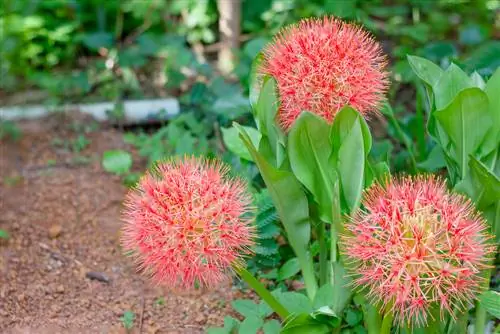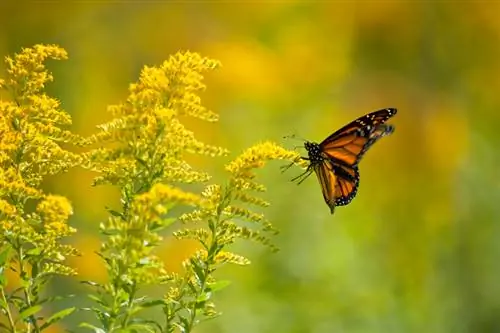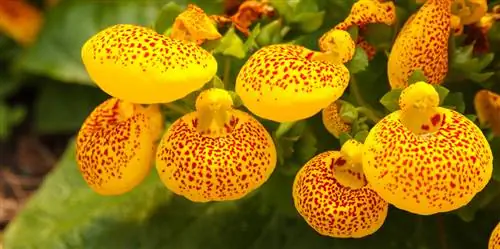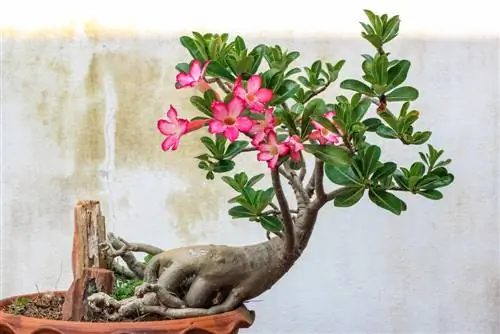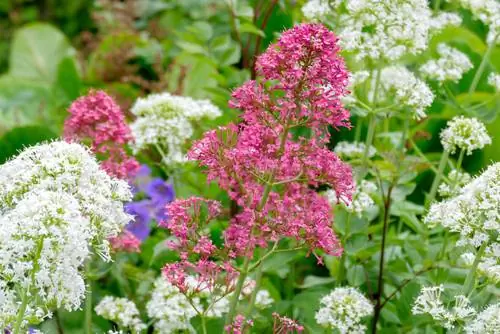- Author admin [email protected].
- Public 2023-12-16 16:46.
- Last modified 2025-06-01 06:02.
Read a commented profile about the blood flower here. Care tips explain how to properly water, divide and overwinter blood flowers. Haemanthus and Scadoxus multiflorus briefly explained.
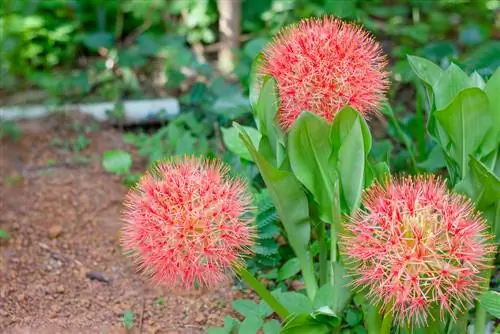
How do you properly care for a blood flower?
The blood flower is an exotic bulbous plant from the genera Haemanthus and Scadoxus. The ideal location is bright and warm all year round. Water evenly, moistly without waterlogging and fertilize with flowering plant fertilizer during growth. Leave to rest at 12-18 °C in winter and water less.
Profile
- Scientific names: Haemanthus and Scadoxus
- Family: Amaryllis family (Amaryllidaceae)
- Genera: Haemanthus (approx. 20 species), Scadoxus (approx. 9 species)
- Synonyms: African Blood Flower, Fire Flower
- Occurrence: South Africa
- Growth type: onion plant
- Growth height: 20-30 cm or 50-60 cm
- Flower: doldig
- Leaf: lanceolate, fleshy
- Root: tuber
- Toxicity: poisonous
- Winter hardiness: sensitive to frost
- Use: Houseplant
Two genera - one name
The amaryllis family includes two genera called blood flowers. Because the 20 Haemanthus species differ in many ways from the 9 Scadoxus species, they were separated into two genera. Although the common name Blutblume is the correct translation of Haemanthus, the name has become common for both genera. The following table points out striking differences using the example of two well-known species:
| Species comparison | Haemanthus coccineus | Scadoxus multiflorus |
|---|---|---|
| Synonym | Blood Flower, | Blood Flower, Fire Flower |
| Growth height | 20 cm to 30 cm | 50 cm to 60 cm |
| Flower shape | half round, cup-shaped | doldig, spherical |
| Flower color | scarlet | orange red |
| Flowering time | July to October | July and August |
| leaves | 60 cm long, 20 cm wide | 45 cm long, 10 cm wide |
Beyond that, there are no significant differences. Hobby gardeners appreciate this fact because care instructions for all amaryllis plants with the name blood flower are applicable.
Bloom
The blossom of a blood flower is perched on a strong, fleshy stem. This thick inflorescence stem pushes out of the tuber before the leaves emerge. A semicircular, cup-shaped or spherical inflorescence is composed of numerous hermaphrodite, star-shaped individual flowers with strikingly long stamens. In this way, a floral ecological unit is created that insects recognize as a flower. As a reward for pollination, each individual flower provides plenty of nectar and pollen.
Video: Admire the blood flower blossom in time lapse
Root
The power from which an African blood flower derives its impressive beauty lies in its roots. As is typical for onion flowers, a thick, underground tuber serves as a survival organ and energy store. In addition, the bloodflower bulb sprouts long root strands underneath before the flower stalk pushes skyward.
Plant Blood Flower
Different paths lead to a blood flower as a representative houseplant. The easiest and most expensive option is to buy a blooming fire flower. Alternatively, you can purchase and plant a bloodflower bulb. Experienced hobby gardeners opt for propagation and save money. Read important information about the procedures in the following sections:
Propagate
These methods are available for growing a blood flower:
- Vegetative propagation: Cut off the bulbs or side shoots, plant them and let them root.
- Generative propagation: Sow seeds 1 cm deep in coconut soil, place in a light and warm place (25° Celsius).
Ask your hobby gardener friends in early spring about cuttings of a blood flower. Certified seeds can be bought cheaply from specialist exotic plant shops. The disadvantage of every propagation method is that you have to wait years for the first flowering period.
Planting a tuber
Plant the blood flower tuber in a humus-rich, loose potting soil without peat. Mix some sand and expanded clay into the substrate to improve permeability. Before you fill in the soil, cover the bottom of the pot with a drainage layer made of pottery shards to protect against harmful waterlogging. Use a container deep enough for the long roots. The maximum distance between the bulb and the edge of the pot is 4 centimeters. Plant the tuber so deep that the tip is still visible and water sparingly.
The premium species Scadoxus multiflorus is so robust that you can plant the tuber in a loamy-sandy bed in the winter garden.
Location
The blood flower can stay in a bright, warm place in the living room all year round. A change of location to suit the season is beneficial for vitality and flowering. The following overview gives the details:
- Temperature minimum: 12° Celsius
- All year round: bright to partially shaded at normal room temperatures and without blazing midday sun.
- Ideal: from May to August/September a sunny to partially shaded, warm spot on the balcony or terrace.
- Advantageous: keep deciduous species dark and cool from October to March, evergreen species bright and temperate
Most exotic potted plants benefit from a dormant period in winter. The rule of thumb for the winter quarters is: the darker, the cooler it can be, as long as the temperature does not fall below the minimum. Evergreen blood flowers, such as Haemanthus albiflos, continue to photosynthesize and prefer a bright location at 16° to 18° Celsius.
Excursus
Amaryllis plants that bloom in winter
When the blood flower sinks into its winter rest phase, a prominent family member continues the flower festival. Amaryllis, also known as knight's stars (Hippeastrum), bloom when it is stormy and snowing outside. You determine when the magnificent flowers appear by planting time. Indoor gardeners prefer to plant the tuber in the ground in mid-October to early November for a red blossom display under the Christmas tree.
Care for Blood Flower
Exotic bulb flowers, such as the blood flower, have special requirements. The greatest danger to the tuber is waterlogging as a trigger for devastating rot. Further care measures promote magnificent blooms and a long life as a spectacular indoor beauty. It's worth taking a look at the following care instructions so that you can enjoy your blood flower for many years:
Pouring
The blood flower is watered with room temperature tap water or rainwater. The current water requirement depends on the condition of the substrate surface and the time of year. How to water a fire flower correctly:
- Basic rule: Before each watering, use a finger test to check whether the soil is dry.
- During the growth and flowering period: keep evenly moist without waterlogging.
- During the dormant phase: water sparingly without letting the soil dry out.
- Extra tip: If in doubt, spray evergreen blood flowers with soft water and only water them later.
Excess irrigation water collects in the saucer and can rise into the root ball due to capillary force and cause waterlogging. By filling the coaster with expanded clay, grit or lava granules, this danger is averted.
Fertilize
Nutrient reserves stored in the tuber should be replenished regularly. This can be done with a liquid fertilizer (€14.00 on Amazon) for flowering plants. A blood flower is fertilized from spring to late summer. The correct dosage can be found on the packaging. If the plant stops flowering, please stop supplying nutrients.
Wintering
Professional wintering has already been discussed in these planting and care instructions. The following overview summarizes all important aspects:
- Bloodflower overwinter dark and cool at 12° to 15° Celsius, place evergreen species in a lighter place at 16° to 18° Celsius.
- Water sparingly, do not let the soil dry out.
- Do not fertilize during the dormant phase.
Repotting
A blood flower does not need to be repotted every year. Write this care measure down on the schedule every two to three years. The ideal time window is from the end of February to the beginning of April. As a rule, the onion has increased in volume. You can either use a larger pot or divide the tuber, as explained in the following section.
Share
If flowering slows down, dividing your blood flower will give you new courage to live. With good care, this procedure is only necessary every 7 to 8 years. The best time is at the end of the dormant phase, when you are repotting the houseplant anyway. Cut the onion cluster into pieces. Plant each tuber segment in a suitable flower pot and water.
Cutting
After the flowering period, blood flowers gradually move in. The plant transfers remaining nutrients from the above-ground parts of the plant into the tuber as a depot for the next season. The process can be recognized by yellowed leaves and wilted flowers. Wait for this process. Cut off completely dead leaves and the retracted stem with a sharp, disinfected knife.
Blood flower doesn't bloom - what to do?
Various reasons cause a blood flower to keep the longed-for blossom under lock and key. The following table lists common triggers for the dilemma and gives tips for countermeasures:
| Cause | Countermeasure | What to pay attention to? |
|---|---|---|
| Waterlogging | repotting | don’t water for a week |
| Cold | Change location | bright at 18° to 20° Celsius |
| Exhausted | share | unstuff, cut off kindle |
| Nitrogen overfertilization | fertilize properly | Use phosphorus-potassium liquid fertilizer |
| Lack of rest period | Let it rest for 3 months | overwinter cool and dark |
Popular varieties
Of the 20 Haemanthus species and 9 Scadoxus species, only a few beauties have made the career leap into houseplants:
- Elephant ear (Haemanthus albiflos): rare, evergreen blood flower with white flowers, height 20-30 cm.
- Blood flower 'King Albert': Hybrid of Scadoxus multiflorus and S. puniceus with extra large flower balls.
- Brush lily (Scadoxus puniceus): impresses with dense, orange-red inflorescences in the shape of a brush.
- Spotted Early Bloodflower (Scadoxus puniceus): boasts orange-red, semicircular flowers from March.
FAQ
Where can you buy a Blood Flower?
Premature blood flowers are rarely found in stores. The best chance of getting a flowering specimen is in late summer. As a source for purchasing flowering bulbs, we recommend contacting an online store in the bulb motherland, such as bulbi.nl or bakker.com; both based in the Netherlands. With a little luck, during the planting season you will find what you are looking for at blumenzwiebelversand.de, Amazon or Ebay.
Are blood flowers poisonous?
The botanical classification of the Amaryllis family already suggests this. Blood flowers are mildly to moderately poisonous. For example, plant parts of Scadoxus cinnabarinus are used by African natives as arrow poison. The highest concentration of toxic ingredients is in the tuber. Consuming large quantities can cause distressing symptoms of poisoning, such as nausea, vomiting and diarrhea.
When will the blood flower be repotted?
A blood flower signals when things are getting too tight in the pot. At the latest when the roots grow out of the opening in the ground, it is necessary to move to a larger container with fresh, sandy, humus-rich potting soil. The best time is shortly before the start of the new season between the end of February and the beginning of April.

